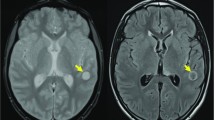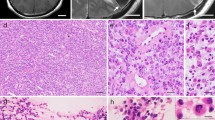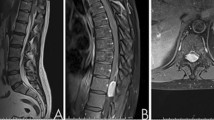Abstract
Introduction
Ependymoma metastasis occurs usually along with local recurrence within 7 years after the initial diagnosis. Later spinal metastasis without local recurrence after the surgical resection has been rarely reported in patients with low-grade ependymomas but not with high-grade ependymomas. Here, we present a case with autopsy revealing late extensive supratentorial metastasis of a fourth ventricle classic WHO grade II ependymoma with no local recurrence or spinal metastasis.
Methods
A 4-year-old boy underwent a gross total resection (GTR) of the fourth ventricle ependymoma and postoperative radiation therapy. Follow-up MRI showed no recurrence for the next 7 years, but a half year later, extra-axial tumors in the left cerebellopontine angle and right frontal lobe were observed. GTR of the left cerebellopontine angle ependymoma was performed, followed by additional radiation therapy.
Results
He was stable for the following 2 years before MRI revealed growth of the right frontal tumor and new lesions. GTR of the right frontal tumor demonstrated similar pathologic features of ependymoma. Despite chemotherapy, follow-up MRIs exhibited increasing numbers and sizes of supratentorial tumors but no infratentorial or spinal tumors. He died 15 years after the initial diagnosis. Postmortem brain examination confirmed the supratentorial subarachnoid dissemination with multifocal metastases of classic ependymomas but no recurrence at the infratentorial sites.
Conclusion
Our case study and literature review suggest that low-grade ependymomas under the current WHO classification have the risk of late metastasis. Therefore, long-term follow-up of the whole neuroaxis is more important for the patients with low-grade ependymomas even in the absence of local recurrence.




Similar content being viewed by others
References
Ernestus RI, Schröder R, Stützer H, Klug N (1997) The clinical and prognostic relevance of grading in intracranial ependymomas. Br J Neurosurg 11:421–428
McLendon RE, Wiestler OD, Kros JM, Korshunov A, Ng HK (2007) Ependymal tumours. In: Louis DN, Ohgaki H, Weistler OD, Cavenee WK (eds) WHO classification of tumors of the central nervous system, 4th edn. IARC Press, Lyon, pp 74–80
Louis DN, Reufebberger G, Brat DJ, Ellison DW (2008) Tumors: introduction and neuroepithelial tumors. In: Love S, Louis DN, Ellison DW (eds) Greenfield’s neuropathology, Vol 2, 8th edn. Hodder Arnold Publishers, London, p 1888
Godfraind C (2009) Classification and controversies in pathology of ependymomas. Childs Nerv Syst 25:1185–1193
Zülch KJ (1981) Historical development of the classification of brain tumours and the new proposal of the World Health Organization (WHO). Neurosurg Rev 4:123–127
Scheithauer BW (2009) Development of the WHO classification of tumors of the central nervous system: a historical perspective. Brain Pathol 19:551–564
Ernestus RI, Wilcke O (1990) Spinal metastases of intracranial ependymomas. Four case reports and review of the literature. Neurosurg Rev 13:147–154
Robertson PL, Zeltzer PM, Boyett JM et al (1998) Survival and prognostic factors following radiation therapy and chemotherapy for ependymomas in children: a report of the Children’s Cancer Group. J Neurosurg 88:695–703
Chamberlain MC (2003) Ependymomas. Curr Neurol Neurosci Rep 3:193–199
Zacharoulis S, Ji L, Pollack IF et al (2008) Metastatic ependymoma: a multi-institutional retrospective analysis of prognostic factors. Pediatr Blood Cancer 50:231–235
Rezai AR, Woo HH, Lee M, Cohen H, Zagzag D, Epstein FJ (1996) Disseminated ependymomas of the central nervous system. J Neurosurg 85:618–624
Nakasu S, Ohashi M, Suzuki F, Matsuda M (2001) Late dissemination of fourth ventricle ependymoma: a case report. J Neurooncol 55:117–120
Bademci G, Tun K, Erden E, Evliyaoglu C, Unlu A (2007) Late dissemination of ependymoma: case report. Neurocirugia (Astur) 18:333–336
Ochiai H, Yamakawa Y, Kawano H, Shimao Y, Hayashi T (2010) Late spinal cord metastasis of fourth ventricle ependymoma appeared nineteen years after the initial treatment. J Neurooncol 96:295–299
Newton HB, Henson J, Walker RW (1992) Extraneural metastases in ependymoma. J Neurooncol 14:135–142
Nawashiro H, Toyooka T, Matsumoto H, Kobayashi O (2002) Infantile ependymoma with cerebrospinal dissemination at diagnosis. J Pediatr 140:276
Fouladi M, Helton K, Dalton J et al (2003) Clear cell ependymoma: a clinicopathologic and radiographic analysis of 10 patients. Cancer 98:2232–2244
Kawabata Y, Takahashi JA, Arakawa Y, Hashimoto N (2005) Long-term outcome in patients harboring intracranial ependymoma. J Neurosurg 103:31–37
Lassaletta A, Perez-Olleros P, Scaglione C et al (2007) Successful treatment of intracranial ependymoma with leptomeningeal spread with systemic chemotherapy and intrathecal liposomal cytarabine in a two-year-old child. J Neurooncol 83:303–306
Dulai MS, Caccamo DV, Briley AL, Edwards MS, Fisher PG, Lehman NL (2010) Intramedullary papillary ependymoma with choroid plexus differentiation and cerebrospinal fluid dissemination to the brain. J Neurosurg Pediatr 5:511–517
Pencovich N, Bot G, Lidar Z et al (2014) Spinal ependymoma with regional metastasis at presentation. Acta Neurochir (Wien) 156:1215–1222
Antony R, Wong KE, Patel M et al (2014) A retrospective analysis of recurrent intracranial ependymoma. Pediatr Blood Cancer 61:1195–1201
Acknowledgments
The authors thank Drs. Clarissa Fauth, Sushil Parai, and Consolato Sergi for their help in collecting the brain for this postmortem neuropathologic study and Ms. Clare McDonald for her help in providing clinical information.
Conflict of interest
The authors are not receiving any financial or material support in conjunction with the generation of this submission. The authors have no personal financial or institutional interest in any of the drugs, materials, or devices described in this article.
Author information
Authors and Affiliations
Corresponding author
Rights and permissions
About this article
Cite this article
Alshaya, W., Mehta, V., Wilson, B.A. et al. Low-grade ependymoma with late metastasis: autopsy case study and literature review. Childs Nerv Syst 31, 1565–1572 (2015). https://doi.org/10.1007/s00381-015-2744-0
Received:
Accepted:
Published:
Issue Date:
DOI: https://doi.org/10.1007/s00381-015-2744-0




